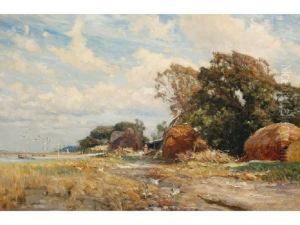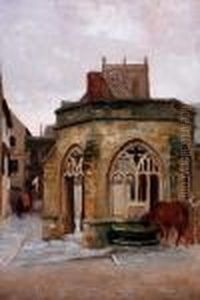Frederick William N. Whitehead Paintings
Frederick William Newton Whitehead was an English artist known for his pastoral and landscape paintings, which often featured the serene and bucolic English countryside. Born on August 24, 1853, in Leamington Spa, Warwickshire, Whitehead was the eldest son of a well-to-do family. He developed an early interest in art, which was nurtured by his family's support.
Whitehead began his formal training at the Royal Leamington Spa Art School before moving on to study at the prestigious Royal Academy Schools in London. His education there provided him with a solid foundation in the techniques of the time and exposed him to the works of the leading artists of the Victorian era.
Whitehead's work was characterized by a meticulous attention to detail and a profound appreciation for nature. His paintings often included elements such as thatched cottages, country lanes, and rural workers, which were rendered with a sense of realism and romanticism. He was particularly adept at capturing the changing qualities of light and atmosphere, which added a lyrical quality to his compositions.
Throughout his career, Whitehead exhibited widely, including at the Royal Academy, the Royal Society of British Artists, and elsewhere. Despite the rise of modernist trends in art during his lifetime, Whitehead remained committed to his traditionalist style, which continued to find favor with the public.
Later in life, Whitehead was recognized for his contribution to the arts. He settled in the Lake District, which provided ample inspiration for his landscape paintings, and where he became an active member of the local artistic community. Frederick William Newton Whitehead passed away on March 4, 1938, leaving behind a legacy of work that continues to be appreciated for its detailed and affectionate portrayal of the English landscape.























